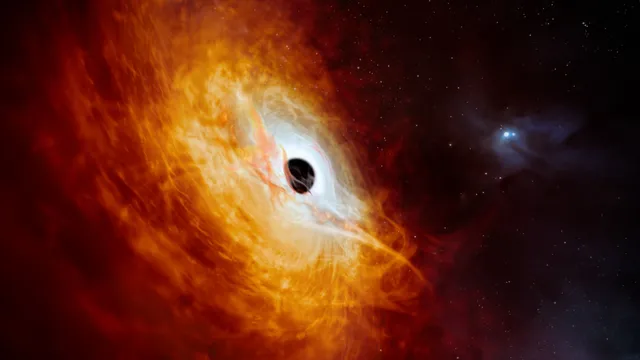A massive black hole at the heart of a galaxy in the constellation Virgo is waking up, firing off intense X-ray bursts at regular intervals that have baffled scientists.
Previously, astronomers had no reason to pay attention to the galaxy SDSS1335+0728, which lies 300 million light-years from Earth.
But in 2019, the galaxy suddenly began to glow with a brightness that turned some telescopes in its direction.
Then, last February, Chilean astronomers began noticing regular bursts of X-rays coming from the galaxy.
This was a sign that the galaxy's sleeping black hole was waking up from its slumber, according to the study published in the journal Nature Astronomy and cited by AFP.
Most galaxies, including our Milky Way, have a supermassive black hole at their heart like a spider in a web.
These invisible monsters devour everything in their path - not even light can escape their almighty vacuum.
If an unlucky star gets too close, it is torn to pieces.
The star's shattered material turns into a stream that swirls rapidly around the black hole, forming a so-called accretion disk that is gradually swallowed up.
But black holes can also go through long periods of inactivity when they are not attracting matter.
And after a rather turbulent period, the bright, compact region at the heart of the galaxy SDSS1335+0728 was classified as an “active galactic nucleus” - and given the nickname “Anski”.
“This rare event allows astronomers to observe the behaviour of a black hole in real time” using several X-ray telescopes, said astronomer Lorena Hernandez-Garcia of Chile's Valparaiso University.
Anski's short-lived X-ray bursts are called quasiperiodic flares, or QPEs.
“This is the first time we are observing such an event in a black hole that seems to be waking up,” Hernandez-Garcia said.
“We still don't understand what causes them,” she added.
The current theory is that QPEs are associated with accretion disks, which form after black holes engulf stars.
But there is no indication that Anski has recently swallowed a star.
And its eruptions are quite unusual.
“The X-ray bursts from Ansky are 10 times longer and 10 times brighter than those we see from a typical QPE,” pointed out Joheen Chakraborty, a doctoral student at MIT and a member of the research team.
“Each of these eruptions releases a hundred times more energy than we've seen elsewhere,” Chakraborty added.
The 4.5-day intervals between these bursts are also the longest ever observed.
“This takes our models to the limit and challenges our previous ideas about how these X-ray bursts are generated,” he said.
Astronomers have had to come up with some theories about what might be causing these strange bursts.
One was that the accretion disk was formed by gas being sucked into the black hole, which only fires X-ray bursts when a small celestial object, such as a star, crosses its path.
“Just imagine a black hole and a disk around it,” explained Norbert Schartel, chief scientist of the European Space Agency's XMM-Newton telescope, which has observed Anski.
Now imagine that the star crosses the disk twice on each of its orbits - shooting out flares - but at a certain angle, meaning “there's no real strong force pulling it in,” he said.
X-ray astronomer Erwan Quintin said that “for QPE, we're still at a point where we have more models than data.”
“We need more observations to understand what is happening,” he added. | BGNES

 Breaking news
Breaking news
 Europe
Europe
 Bulgaria
Bulgaria







